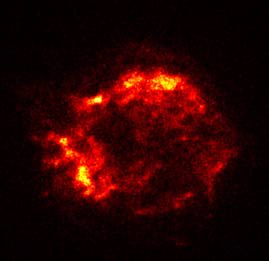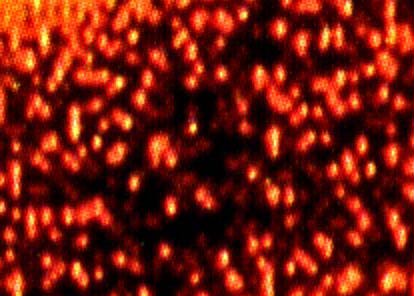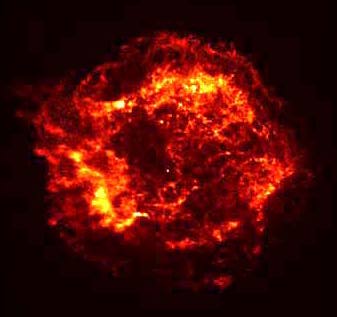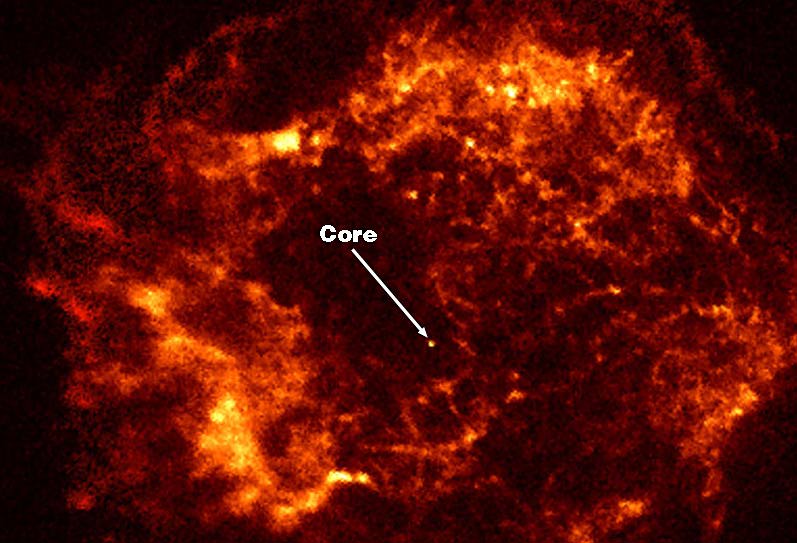
(This image is from the ROSAT satellite, obtained at -- http://ledas-www.star.le.ac.uk/rosat/images/casa_sm1.gif)
The accompanying text states:
"Supernova remnants, like this one in the constellation of Cassiopeia, named Cas A, are the final debris from the supernova explosions that mark the end-point of the lives of massive stars. The collision between the supernova shell, expanding outwards at a speed of around 10,000 km per second, and interstellar gas heats the gas to very high temperature. As a result in this ROSAT image we can see the 10 million-degree gas in the supernova shell glowing brightly in the X-ray band. The original supernova explosion that produced Cas A took place around 400 years ago but was not seen by astronomers according to historical records. The probable explanation for this is that the supernova explosion occurred in a relatively obscured and distant part of our Milky Way, making it much less dramatic than other supernovae in recorded history such as those associated with the Crab Nebula, or SN1006."
The Ball-of-Light Particle Model does not agree with this traditional view of how supernova remnants heats gas by colliding with interstellar gas. If this was correct, then the "shell" would be relatively thin. Expanding material from the supernova that lies within the shell should not make additional knots because, the outer thin shell would have already plowed the interstellar gas out of the way. Furthermore, studies of hypersonic impacts of material demonstrate that small compact "knots" or spherical objects would not be made. Rather, "mushroom-like" regions would be made. It is possible, that some of the outer shell of supernova remnants really do collide with interstellar gas and make some mushroom-like regions. However, in the following enlarged image of Cass A, it is possible to see the decaying balls-of-light.
This is an enlarged portion of an image -- I believe originally from the above ROSAT satellite image -- of Cassiopeia's expanding shell. The Ball-of-Light Particle Model predicts each intense X-ray source is a ball-of-light. These balls-of-light are smaller parts of the original ball-of-light that was the star's core before it exploded. These objects are literally very large "elementary" particles. (See also, The First Energy Level and associated diagrams) These particles are not very stable. Their only stability is a result of their high speed. As they slow, they become less stable. (See also, Zones of Instability for a galactic example of this at a higher energy level.) The Ball-of-Light Particle Model predicts that if scientists monitor each of these balls-of-light over time they will discover that they sometimes will be observed to split into smaller particles and/or explode. (This would not occur if these objects really are created by collisions between the supernova remnants and interstellar gas. Obviously, I would be in favor a project that would monitor Cass A's details with high precision over a long time. An animation of the these objects over time would surely settle any debate.)

Decaying balls-of-light within the expanding explosion from the supernova Cassiopeia A are creating bright sources of x-rays.
It is widely believed by scientists that the expanding shell of material called Cassiopeia A is created by a supernova -- an exploding star. The Ball-of-Light Particle Model agrees with this. However, there is a difference.
The Ball-of-Light Particle Model predicts that the bright knots of material in Cass A's expanding shell are a result of extremely unstable, rapidly decaying balls-of-light. These decaying balls-of-light have very intense electromagnetic fields on their cores that induce other, smaller balls-of-light. Some of these objects will create spectra that are unidentifiable by scientists because it is impossible to make such particles here on earth. As a result, the Ball-of-Light Particle Model predicts this expanding shell should create unusual thermal radiation -- with spectra from heavy nuclei such as silicon, sulfur, and magnesium -- and nonthermal radiation directly from these surface of the decaying balls-of-light.

Low resolution CHANDRA x-ray satellite image of Cass A. Note, the bright point that represents the still radiating central core. If everything is exploding away from the core, then how can traditional theory reconcile the bright core? Traditional theory would state that material is spiral into the neutron core, exploding and then giving off x-rays. How can everything be moving away from the core at such high speed and moving towards the core to give of x-rays?

Higher resolution image of Cassiopeia A from the CHANDRA x-ray telescope. Note: every location is an x-ray bright point, from a decaying ball of light. Note also the larger "knots" -- also decaying balls of light. If this telescope is supposed to have 10 times the resolution of any prior x-ray telescope, then we do not really see the best image here. Why haven't they released the better images? Do these two bottom images look 10 times better than the top two images?